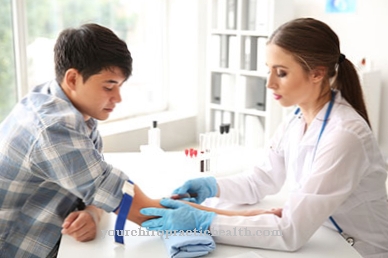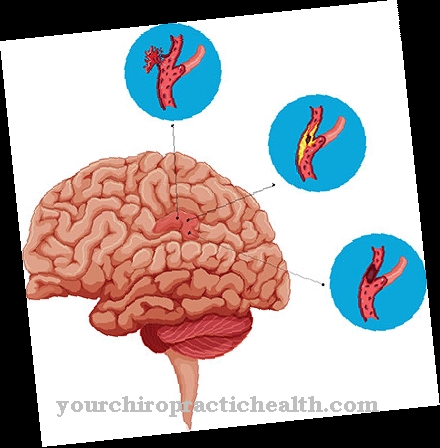Fibroids are benign growths of the uterus and commonly called Uterine tumor known. Smaller fibroids are harmless and rarely require medical treatment. If symptoms arise, however, a visit to the doctor is essential in order to keep fibroids under control and, if necessary, to remove them.
What is a fibroid?
A Myoma is a benign tumor that grows slowly in the muscle wall of the uterus. Fibroids do not metastasize and can grow or bulge in the wall of the body of the uterus.
A smaller myoma is about the size of a pea. The size of an orange is also not uncommon. In extreme cases, the size of a fibroid can mimic pregnancy. A fibroid arises from muscle fibers and enlarges through the influence of hormones.
Fibroids affect more than 20% of all women. It most commonly affects women between 35 and 55 years of age. A fibroid can be malignant in less than one percent of all cases.
causes
Why a Myoma arises cannot be clearly defined. It has been shown that fibroids can be inherited in part. It is also considered certain that the sex hormone estradiol plays a role in the development of myomas.
Fibroids do not occur in girls before puberty. They only grow when the body has an elevated level of estrogen. This is the case, for example, during pregnancy or when taking hormone preparations.
During the menopause, the level of estrogen drops and causes the fibroids to shrink. Myoma no longer occurs in postmenopausal women.
Symptoms, ailments & signs
Fibroids cause different symptoms, depending on their size and location. If they are still small, they often do not cause any complaints and are therefore only discovered by chance. The most common symptom is pain, which can increase to extremely strong, labor-like cramps, usually during the menstrual phase.
Depending on their location, fibroids can put pressure on nerves, which can cause pain that extends to the legs or back. Uncomfortable painful pressure can be felt during physical exertion or sexual intercourse. Large fibroids can constrict the bladder or bowel, causing increased urination or constipation.
It rarely happens that the urethra is completely squeezed off and urination is no longer possible. This would require immediate medical treatment. Extremely large fibroids can increase the size of the abdomen. In addition, there are bleeding disorders. The period can be unusually heavy because the growth prevents the bleeding vessels from closing quickly enough.
Menstruation often lasts longer than normal. The amount of blood excreted is significantly increased, sometimes it comes off like a surge. Due to the increased blood loss, the blood iron level drops and there is an iron deficiency. Typical signs of this are tiredness, fatigue, racing heart, pale skin color, brittle nails and hair loss.
Diagnosis & course
.jpg)
A smaller one Myoma often goes unnoticed and is only discovered by chance during routine examinations. If menstrual cramps, spotting or prolonged bleeding occur, a doctor should be consulted.
He will first perform a gynecological examination. A fibroid can often be felt by feeling. Ultrasound or a cell examination with a smear will provide certainty. If an endoscopy is performed, a special endoscope is inserted through the vagina into the uterus. The uterus is filled with gas and illuminated.
A smaller fibroid doesn't cause symptoms. If the fibroid is larger, it can cause pain or menstrual complications. Larger fibroids change the shape of the uterus. In pregnant women, the fetus is pushed into unusual positions. It can lead to miscarriages. A fibroid can also put pressure on the rectum and bladder.
Complications
A tumor in the uterus can cause various symptoms. First and foremost, women suffer from cycle disorders and thus also from relatively severe menstrual pain. These can also lead to mood swings and thus significantly reduce the quality of life of those affected. There is also dizziness and paleness.
Those affected appear exhausted and weak and also suffer from circulatory problems. It is not uncommon for this to lead to a loss of consciousness. Especially in pregnant women, a uterine tumor can be a serious complication and, in the worst case, lead to a miscarriage. In most cases, no specific treatment is necessary for a uterine tumor. Those affected are, however, dependent on regular visits and checks by a gynecologist.
In some cases, the uterine tumor also needs to be surgically removed. However, there are no complications and the life expectancy of the patient is not reduced. Even after the treatment, a uterine tumor can come back. In many cases, the fibroid can also be treated with medication.
When should you go to the doctor?
Menstrual disorders and irregularities in a sexually mature woman should be clarified by a doctor. If bleeding or spotting occurs outside of your normal menstrual period, you should see a doctor for a check-up. If you experience discomfort during intercourse, there is cause for concern. Pain, pressure, or pain in the abdomen should be examined and treated. Disorders of the digestive tract, diarrhea or constipation are signs of impaired health. A doctor's visit is necessary as soon as the symptoms persist for a long time or if they increase in scope or intensity.
In the event of swelling in the abdomen, palpable lumps or changes in the appearance of the skin, the symptoms should be presented to a doctor. If there is a decrease in general performance, fatigue or internal weakness, a doctor is required. Palpitations or irregular heartbeat rhythm should be discussed with a doctor. A state of anxiety, an inner insecurity, insomnia or changes in urination are indications that should be monitored further.
If they have a constant occurrence, it is advisable to consult a doctor. A doctor should check for pale appearance, sudden hair loss, or irregularities in the fingernails or toenails. The cause is determined in various tests so that treatment to alleviate the symptoms can be initiated.
Treatment & Therapy
A small Myoma do not necessarily have to be treated. Regular checks by the gynecologist are sufficient. A smaller myoma can be removed with a uterine specimen. For this rather unpleasant procedure, the patient is given local anesthesia or anesthesia.
Larger fibroids require surgical removal through an incision in the abdomen. If multiple fibroids develop, the entire uterus often has to be removed. A larger myoma can be made to shrink by giving hormones. Surgical removal is then possible, whereby the uterus can be preserved.
A new method is causing a sensation in special clinics. Here, the fibroid is allowed to shrink by blocking the surrounding blood vessels. This is done by means of injection. The type of therapy can depend on various factors. These include the size and location of the growth, the symptoms caused or the age of the patient and the associated status of family planning.
Therapy usually aims to preserve the uterus. However, if the fibroid grows overgrown and causes great pain, a hysterectomy is often unavoidable.
New drug treatment options
The hormone treatment with GnRH analogues that has been tried and tested for many years is now being supplemented by the new therapy against symptomatic uterine fibroids with the active ingredient ulipristal acetate. It is taken in tablet form. The indication is the preoperative treatment of moderate and severe symptoms - for example, pelvic complaints, fatigue or pain - as well as long-term treatment. One tablet is taken daily for a period of up to twelve weeks. If necessary, the treatment can be repeated, there is no time limit for this.
The active ingredient ulipristal acetate reduces the volume of the fibroids and, at the same time, the associated symptoms. This means that surgery can often be avoided. The long-term therapy mentioned is ideal for women who are still about to go through menopause and who want to get through menopause without surgery. Once the menopause is over, the risk of fibroids disappears too. Because of the reduction in the hormones progesterone and estrogen, these no longer grow. Long-term therapy is also suitable for women who complain of severe symptoms, who want to control them effectively and permanently, and who have not yet completed their family planning.
How the tablet works
Ulipristal acetate is one of the selective progesterone receptor modulators, so the active ingredient is used for causal drug therapy. This has a direct influence on the cause of the disease. Not only are the discomfort alleviated, it is also about healing. The activity of progesterone, a hormone that occurs naturally in the body, is inhibited by ulipristal acetate. The preparation itself is not a hormone, which means that it is well tolerated and leads to permanent and rapid relief of the symptoms. The bleeding is reduced or stopped completely, the fibroids become smaller and the pain subsides.
You can find your medication here
➔ Medicines for menstrual crampsOutlook & forecast
The course of the disease depends on the size and location of the tumor. Affected patients should regularly go to the gynecologist for preventive examinations in order to avoid complications. This also applies if fibroids show no symptoms. Urinary tract infections and pain during urination can occur if the tumor is pressing on the bladder.
Functional disorders of the bladder, intestines and kidneys can also occur when the tumor presses on the organs. With heavy or prolonged menstrual periods, iron deficiency often leads to anemia. Furthermore, there are problems with fertility and during pregnancy. In principle, however, the myoma does not represent an obstacle to pregnancy. Because only in a few cases does infertility occur, for example if the tumor lies in front of a fallopian tube.
The fibroid can cause a variety of problems during pregnancy. As an estrogen-dependent tumor, a fibroid grows faster during pregnancy because the body then produces more sex hormones. Due to the increasing size and location, the fibroid can cause pain. Positional anomalies in the unborn child can also occur or even block the birth canal. Premature labor can also occur. A fibroid has been shown to increase premature and miscarriage rates. If the tumor grows in the uterine cavity or under the lining of the uterus, miscarriage and ectopic pregnancies can occur.
prevention
Against a Myoma there are no known preventive measures. Women between 35 and 55 years of age should have six-monthly check-ups at the gynecologist. A myoma can be detected early through palpation examinations and ultrasound.
In this way, complications can be eliminated that can arise if the fibroid is detected too late. If a fibroid has been removed, the patient is not immune to the tumor. A fibroid can recur at any time. Women who have already had problems with a fibroid and consider their family planning complete should consider removing the uterus. A myoma only grows in the muscles of the uterus and can therefore no longer occur in operated patients.
Aftercare
A fibroid is usually not treated because it is small and does not cause acute symptoms. Instead, doctors choose to monitor the benign tumor as part of follow-up care. This happens for two reasons: On the one hand, the myoma can grow and thereby disrupt the function of other organs. On the other hand, scientists assume that the myoma degenerates in a fraction of cases and then tends to metastasize.
The aftercare therefore serves to avoid complications. Doctor and patient agree on a quarterly or half-yearly rhythm. In addition to a palpation examination, there is also an ultrasound examination. Doctors believe that diagnosing change at an early stage has the best chance of recovery. Therefore, the scheduled examinations must be carefully observed.
If the doctor and patient decide to have a fibroid removed, follow-up care is also indicated. This is aimed at eliminating any subsequent symptoms of the procedure and preventing the tumor from recurring. Because the uterine tumor can develop again under certain circumstances.
The scope of the follow-up corresponds to the descriptions above. Participation in a rehabilitation measure immediately after an operation may be necessary. In addition, patients should of course consult their doctor immediately if acute problems arise.
You can do that yourself
Since fibroids generally do not pose a health risk, symptoms can be alleviated through self-treatment. A prompt medical consultation is advisable, depending on the severity and duration of the symptoms. Regular pelvic exams should be performed if fibroids are present.
Most fibroids cause more severe symptoms around the period of menstrual bleeding and a few days before. In order to counteract cramp-like pain, avoiding alcohol and salty foods - as they remove water from the body - and to compensate for more fluids beforehand. This also counteracts common circulatory problems. Coffee and dairy products also put a strain on the body and should be reduced. Some women suffer from iron deficiency due to fibroids. Consumption of green leafy vegetables (chard, kale, nettle, herbs) or taking a ready-made preparation such as is available in pharmacies help here. The ingestion of magnesium also relieved the symptoms. Nuts, avocados, algae and legumes provide important vitamin B, which is also effective against muscle cramps.
In order to support the body in the healing process, stress avoidance and light movement are the top priorities. Alternative healing methods such as acupuncture, acupressure or aromatherapy can also help. The local application of heat with heating pads or warm compresses relaxes the muscles of the uterus and ensures holistic relaxation. St. John's wort oil can be added to a bathtub.


.jpg)










.jpg)

.jpg)
.jpg)











.jpg)